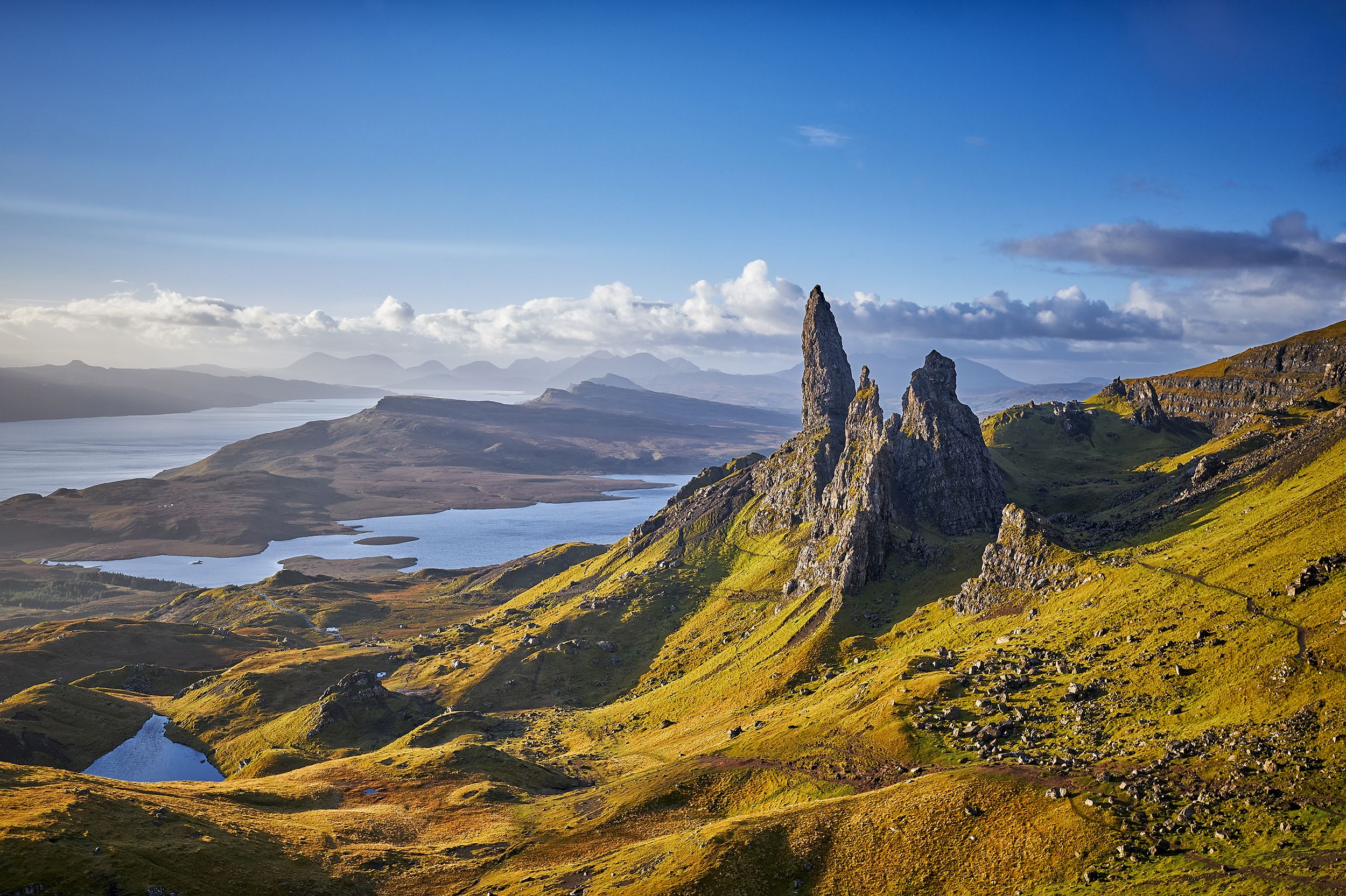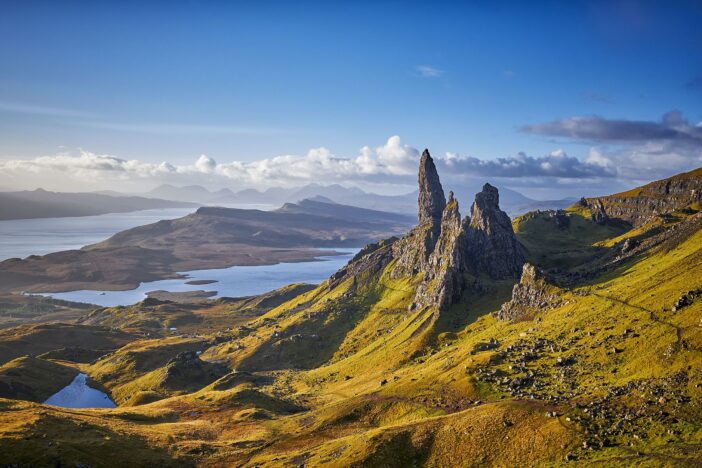Scotland’s islands are a mosaic of breathtaking landscapes, rich histories, and vibrant cultural tapestries. Nestled on the rugged fringes of the United Kingdom, these islands offer a serene escape into nature’s most pristine settings. From the rolling green hills and white sandy beaches to the dramatic cliffs and quiet lochs, each island boasts its own unique character and charm.
There are over 900 Scottish Islands scattered across three main groups: the Hebrides, which are divided into the Inner and Outer Hebrides, the Orkney Islands, and the Shetland Islands. Each cluster offers a distinct experience – from the mystical Skye, known for its dramatic vistas and culinary delights, to the historical Orkney, where ancient Neolithic sites stand remarkably preserved. The Outer Hebrides, with their traditional Gaelic culture and untouched natural beauty, offer a deeper dive into Scotland‘s ancestral roots.
Among these, some islands have become particularly celebrated amongst tourists. The Isle of Skye is perhaps the most famous, drawing visitors with its iconic landscapes like the Old Man of Storr and the Cuillin mountains. Islay is revered by whiskey enthusiasts for its world-class distilleries, while the historical richness of Orkney’s archaeological sites makes it a magnet for history buffs. These islands not only highlight the natural and cultural wealth of Scotland but also cater to a variety of interests and activities, ensuring that every visitor finds their own slice of Scottish paradise.
Why Visit Scotland’s Islands?
Scotland’s islands represent a treasure trove of experiences for any traveler, characterized by their stunning natural beauty, rich cultural tapestries, and diverse wildlife. Each island offers a distinct allure, making them must-visit destinations for those who seek beauty, history, and adventure.

Natural Beauty and Scenic Landscapes
The islands of Scotland are renowned for their spectacular landscapes that range from dramatic mountain vistas to tranquil sandy beaches. The Isle of Skye, for instance, is famed for its rugged beauty, with the Cuillin range offering some of the most challenging and rewarding hikes in Britain. The Quiraing, a unique landslip on Skye, presents landscapes that feel almost otherworldly. In contrast, the Outer Hebrides offer some of the most beautiful beaches in the world, such as Luskentyre on Harris, with its expansive stretches of white sand and turquoise waters.
Mull provides a slightly gentler beauty with its rolling hills and quiet woodlands, punctuated by picturesque villages like Tobermory, known for its colorful waterfront houses. These islands not only promise visual splendor but also a chance to experience the serene, untouched environments that are increasingly rare in today’s world.
Rich History and Cultural Heritage
Scotland’s islands are steeped in history and culture, with each island having its own unique story that contributes to the rich tapestry of Scottish heritage. The Orkney and Shetland Islands, with their roots stretching back to the Viking Age, are littered with historical sites. Orkney’s Skara Brae, a remarkably preserved prehistoric village, and the Ring of Brodgar stand as a testament to the islands’ ancient civilizations.
The Hebrides have a strong Gaelic tradition, and their music, language, and folklore are integral to the identity of the islands. Festivals like the Hebridean Celtic Festival on Lewis celebrate this cultural heritage, drawing visitors from around the world. Historical structures, from the medieval castles like Kisimul Castle in Barra to the ancient standing stones of Callanish on Lewis, offer a gateway into the past, making the islands a fantastic destination for history enthusiasts.
Unique Wildlife and Opportunities for Nature Enthusiasts
For wildlife watchers and nature enthusiasts, the Scottish islands are akin to a paradise. The varied ecosystems support a wide range of species, providing some of the UK’s most fascinating wildlife viewing opportunities. The Isle of Mull is known as one of the best places in Scotland to see golden eagles and white-tailed eagles. The Shetland Islands, meanwhile, are home to significant populations of puffins, making them a favorite for birdwatchers, especially at reserves like Sumburgh Head.
The coastal waters around the islands are just as rich in biodiversity, with frequent sightings of seals, dolphins, and whales. Boat tours are a popular way to explore this marine life, providing the thrilling chance to encounter these creatures in their natural habitat. Moreover, the relative isolation of these islands has helped preserve their environments, making them ideal for studying and enjoying Britain’s natural heritage in an undisturbed setting.
Main Regions of Scottish Islands
Exploring the Inner Hebrides
The Inner Hebrides of Scotland, consisting of dozens of islands each with its own distinct character, offer an unforgettable experience to every visitor. This group of islands boasts a combination of stunning natural landscapes, rich historical sites, and vibrant local cultures, making it an essential part of any Scottish island tour.
Isle of Skye
Skye, the largest and most famous of the Inner Hebrides, is a magnet for nature lovers and photographers thanks to its dramatic mountain ranges, rugged coastlines, and picturesque villages. Key attractions include the Old Man of Storr, the Fairy Pools, and Neist Point Lighthouse. The island’s vibrant cultural scene is reflected in its bustling food markets, live music venues, and the annual Skye Festival, which features music, dance, and theatre.
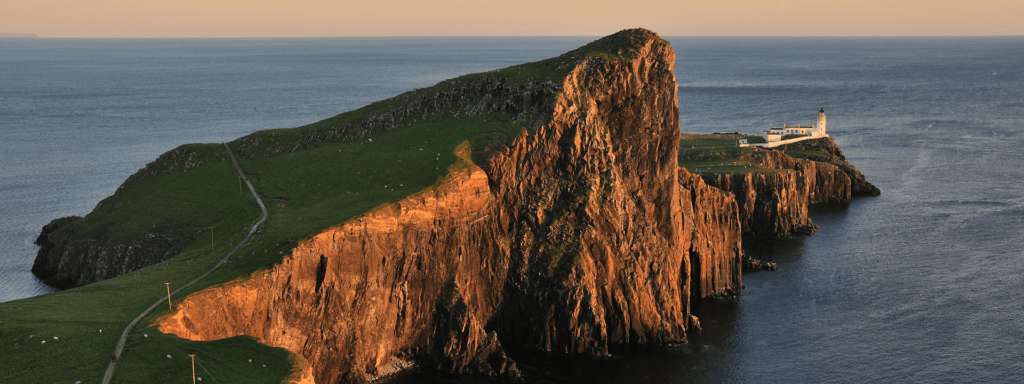
Isle of Mull
Mull is the second-largest of the Inner Hebrides and is celebrated for its diverse wildlife and historical sites. The island is a haven for bird watchers, with the white-tailed eagle being a notable resident. Tobermory, Mull’s colorful capital, offers charming shops, art galleries, and the famous Tobermory Distillery. Historical enthusiasts will enjoy exploring Duart Castle, the ancestral home of the Clan MacLean, which stands proudly overlooking the sea.
Isle of Islay
Known as “The Queen of the Hebrides,” Islay is world-renowned for its whiskey production, housing no fewer than nine distilleries. The island attracts whiskey enthusiasts from around the globe eager to sample its peaty single malts directly from the source. Beyond whiskey, Islay also offers beautiful sandy beaches like Machir Bay, historic sites such as Finlaggan (the ancient seat of the Lords of the Isles), and a rich birdlife that includes choughs and geese.
Isle of Jura
Jura is one of the wildest and least populated islands in the region, known for its rugged terrain, vast deer population, and the iconic Paps of Jura—three prominent hills that are visible from great distances. Jura’s solitary distillery produces a uniquely full-bodied single malt, and the island itself offers tranquility away from the bustling tourist paths, perfect for long, contemplative walks or cycles.
Smaller Islands
In addition to these larger islands, the Inner Hebrides includes numerous smaller islands each worth a visit. Iona, for example, is a tiny island with a big history, known for the Iona Abbey, a key site in the spread of Christianity throughout Scotland. Staffa, with its unique basalt columns and the famous Fingal’s Cave, offers an awe-inspiring natural spectacle influenced by both geology and legend.
Each island of the Inner Hebrides has its own unique blend of beauty, history, and culture, offering visitors a rich and varied experience. Whether you’re exploring ancient ruins, sipping finely crafted whiskey, or hiking through stunning landscapes, the Inner Hebrides provide a deep connection with Scotland’s natural and cultural heritage.
Exploring the Outer Hebrides
The Outer Hebrides, also known as the Western Isles, form a stunning archipelago off the west coast of mainland Scotland. This chain of islands is distinguished by its remote beauty, deep cultural roots, and the tranquility of its natural landscapes. From the northernmost Lewis to the southern isles of Barra, each island presents a unique experience, wrapped in the enduring traditions of Gaelic culture.

Geography and Landscape
The geography of the Outer Hebrides is varied and dramatic, featuring rugged coastlines, vast moorlands, and pristine beaches. Lewis, the largest of these islands, is known for its expansive peat bogs and the famous Callanish Standing Stones, a cross-shaped setting of Neolithic megaliths older than Stonehenge. Harris, though part of the same landmass as Lewis, contrasts sharply with its mountainous terrain and spectacular sandy beaches like Luskentyre and Scarista, which are among the most photographed in Scotland for their stunning blue waters and golden sands.
Further south, the islands of North Uist, Benbecula, South Uist, and Barra each contribute to the archipelago’s charm with their own distinct landscapes and communities. The Uists are characterized by their interconnected freshwater lochs and machair, a unique coastal grassland that blooms with wildflowers in spring and summer.
Cultural Heritage
The cultural heritage of the Outer Hebrides is deeply rooted in Gaelic traditions, evident in the daily lives of its residents. Gaelic is still spoken widely, and traditional music, dance, and crafts are vital components of community life. Visitors can experience this rich culture at local events such as ceilidhs (traditional social gatherings) and music festivals, which often feature Gaelic folk music and the distinctive sound of the bagpipes.
The islands also have a strong tradition of weaving, with Harris Tweed being the most famous export. Authentically produced using local wool and handwoven by the islanders at their homes, Harris Tweed is protected by law and known worldwide for its quality and the sustainability of its production.
Wildlife and Natural Attractions
The natural environment of the Outer Hebrides offers splendid opportunities for wildlife watching. The islands are a haven for birdwatchers, with numerous species of seabirds, including puffins, gannets, and the majestic golden eagles, calling these islands home. The machair lands support a biodiverse ecosystem, providing breeding grounds for a variety of bird species.
Marine life is equally impressive, with regular sightings of dolphins, porpoises, and whales around the coastal waters. The clear and unpolluted waters also make the islands a popular spot for otter sightings, particularly in the early morning or at dusk.
Exploring the Orkney Islands: A Journey Through Time and Nature
The Orkney Islands, a captivating archipelago off the northeastern coast of Scotland, stand out as a destination of profound historical significance and natural beauty. Comprising approximately 70 islands, of which 20 are inhabited, Orkney offers a unique blend of ancient history, vibrant culture, and stunning landscapes. This section explores the key aspects of the Orkney Islands that make them a must-visit location.

Ancient Historical Sites
Orkney is a treasure trove of prehistoric and Norse heritage, making it a fascinating destination for history enthusiasts. The Heart of Neolithic Orkney, a UNESCO World Heritage Site, includes some of the most important Neolithic sites in Europe, providing insights into early human life. This includes the well-preserved village of Skara Brae, which predates the pyramids of Egypt and Stonehenge, offering a glimpse into 5,000-year-old domestic life. Nearby, the Ring of Brodgar and the Standing Stones of Stenness evoke the area’s mystical past, while Maeshowe, a chambered cairn, showcases ancient Norse graffiti dating back to the Viking raiders.
Rich Norse Heritage
The influence of the Norsemen, who ruled Orkney from the late 8th century until 1472 when the islands were annexed to the Kingdom of Scotland, is evident in many aspects of Orcadian life. This Norse heritage is celebrated annually during the Orkney Folk Festival and the St Magnus Festival, both of which feature a mix of local and international artists, highlighting Orkney’s cultural dynamism. The Saint Magnus Cathedral in Kirkwall, founded in 1137 and one of the best-preserved medieval cathedrals in Scotland, stands as a monument to the island’s Norse past.
Dramatic Coastal Landscapes
Orkney’s natural environment is as striking as its history. The islands feature rugged cliffs, secluded sandy beaches, and some of the most dramatic seascapes in the UK. Iconic landmarks such as the Old Man of Hoy, a towering sea stack, draw climbers and photographers alike. The coastline, rich in wildlife, offers opportunities to spot seabirds, seals, and even orcas during certain times of the year. Walking trails along the cliffs of Yesnaby or the beaches of Sanday provide peaceful retreats into nature’s embrace.
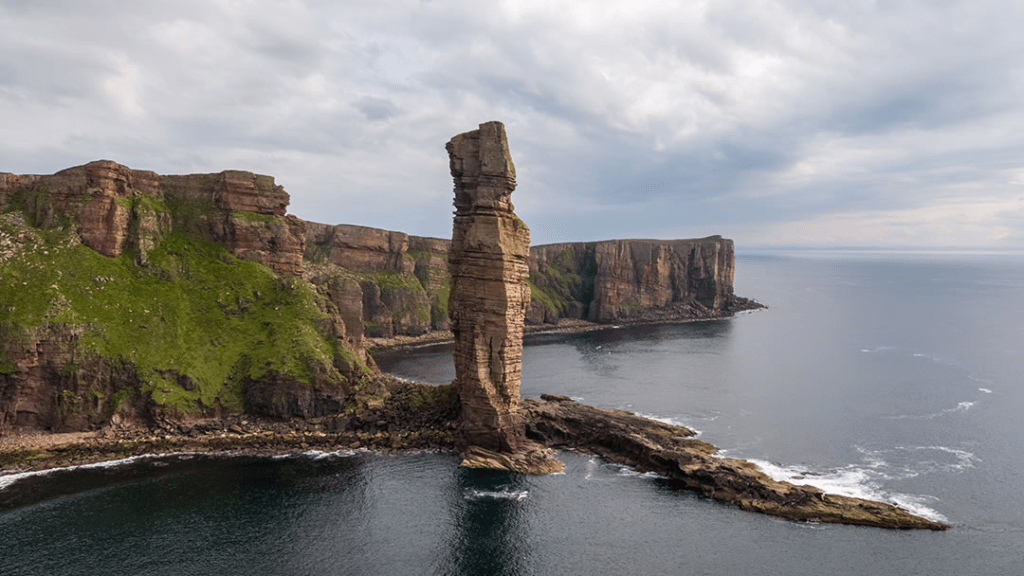
Vibrant Local Life and Crafts
Orkney is also known for its thriving arts and crafts scene, with local artisans drawing inspiration from their rich surroundings and history. Visitors can explore galleries and workshops across the islands, where craftspeople produce everything from traditional Orkney chairs to contemporary jewelry influenced by Norse art. The islands also boast a strong tradition of storytelling and music, which can be experienced at local pubs and community events, offering a warm Orcadian welcome to all.
In summary, the Orkney Islands not only provide a window into ancient civilizations and Viking lore but also offer serene landscapes and a vibrant community life. Whether delving into the mysteries of ancient stone circles, exploring dramatic cliffs and rural landscapes, or engaging with the local culture, a visit to Orkney promises a rich and varied experience that resonates long after the journey ends.
Visitor Experiences
For visitors, the Outer Hebrides offer a chance to step away from the rush of modern life into a world where nature and tradition blend seamlessly. Activities range from hiking and cycling on well-marked trails to kayaking and sailing in the surrounding seas. The islands also provide the perfect setting for more contemplative pursuits like photography and painting, inspired by the spectacular natural scenery and the ever-changing light.
The Outer Hebrides are not just a destination but a journey into a quieter, slower-paced world where the landscape, culture, and community spirit are as enriching as they are captivating. Whether it’s exploring ancient sites, joining in a local festival, or simply enjoying the solitude of a secluded beach, the islands offer a profound sense of connection to both past and present.
Discovering the Shetland Islands: A Blend of Natural Beauty and Viking Heritage
The Shetland Islands, located at the crossroads of the Atlantic Ocean and the North Sea, represent a fascinating blend of Scottish and Norse influences, set against a backdrop of some of the most stunning natural scenery in the UK. As the northernmost point of Scotland, Shetland is an archipelago of over 100 islands, each offering visitors a unique view into a rugged and enchanting landscape.
Geography and Landscape
Shetland’s geography is marked by dramatic cliffs, sweeping sandy bays, and wild, windswept moors. The islands are renowned for their breathtaking coastal views, such as those from Eshaness Cliffs on the mainland, where the Atlantic waves crash against towering volcanic rock formations. Inland, the landscape transforms into peat bogs and heather-covered hills, offering ample opportunities for hiking and nature walks, particularly in areas like Ronas Hill, Shetland’s highest point.
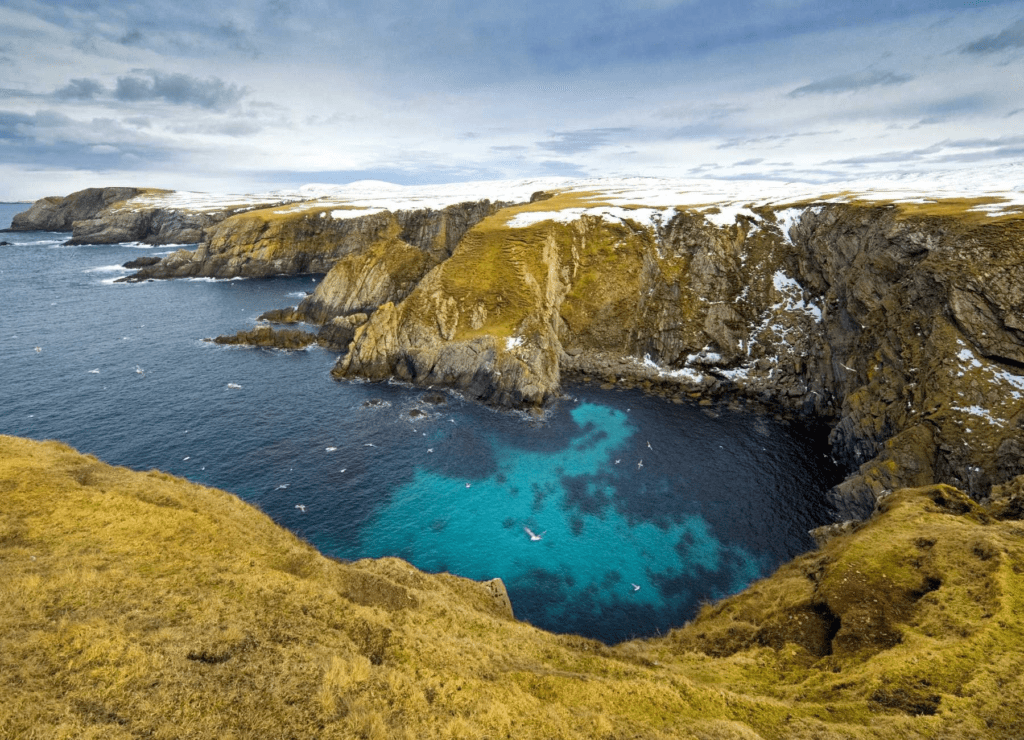
Cultural Heritage
Shetland’s cultural fabric is deeply woven with threads of its Viking past, which is celebrated annually during the Up Helly Aa festival. Held in Lerwick, this fire festival sees locals dressing as Vikings, complete with a torch-lit procession and the burning of a galley. This celebration is a vivid reminder of the islands’ history, echoing through the centuries.
The Shetland Museum and Archives in Lerwick provide a comprehensive overview of the islands’ heritage, from its geological origins to the present day. The islands’ language and place names also reflect their Nordic heritage, with many Shetlandic terms derived from Old Norse.
Wildlife and Natural Attractions
The wildlife in Shetland is as diverse as its landscape. The islands are one of the premier birdwatching spots in the UK, hosting an impressive variety of seabird colonies. The cliffs and islets are alive with the sounds of puffins, guillemots, and gannets, particularly during the breeding season. The Sumburgh Head RSPB reserve is a notable birdwatching location, offering stunning views and close encounters with puffins.
Marine life around the islands is equally rich. The waters of Shetland are frequented by seals, otters, and a variety of cetaceans including orcas and minke whales, making it an excellent destination for wildlife enthusiasts.
Arts and Crafts
Shetland is also known for its vibrant arts and crafts scene, with a strong tradition of textile production. Shetland wool is highly prized, and the skill of local knitters, who create intricate Shetland lace and Fair Isle knitwear, is recognized worldwide. Throughout the islands, visitors can explore workshops and boutiques where these and other crafts are available for purchase.
Other Notable Scottish Islands
Beyond the well-trodden paths of the Hebrides, Orkney, and Shetland, Scotland is dotted with a plethora of lesser-known but equally fascinating islands, each offering unique attractions and experiences. These islands, though not as frequently visited as their more famous counterparts, provide tranquil retreats and a chance to explore Scotland’s hidden gems.
Isle of Arran
Known as “Scotland in miniature,” the Isle of Arran captures the essence of the Scottish landscape, with its rugged mountains in the north and rolling hills and woodlands in the south. Arran is a haven for outdoor enthusiasts, offering excellent hiking, cycling, and golfing opportunities. The island is also rich in history, home to the ancient Brodick Castle and numerous prehistoric stone circles. Additionally, Arran’s local distillery produces some fine Scottish whisky, a treat for those who appreciate fine spirits.
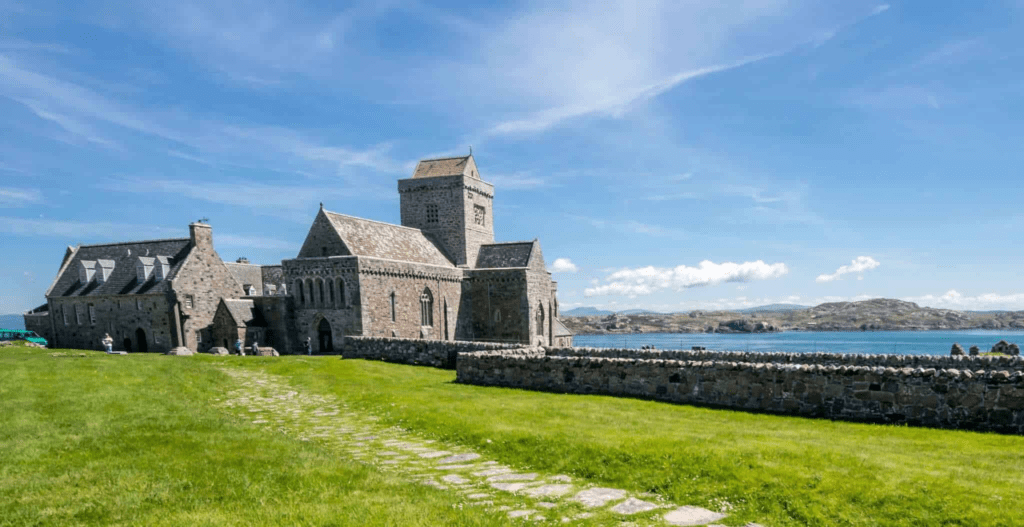
Isle of Iona
Iona is a small island off the southwest coast of Mull, known primarily for its spiritual significance and serene beauty. It is famously the location of Iona Abbey, one of Scotland’s most sacred sites and a pivotal center for the spread of Christianity throughout Scotland. Visitors often come to Iona for retreats and to experience the peaceful atmosphere that has made it a place of pilgrimage for centuries.

Isle of Jura
Jura is one of Scotland’s wildest and least populated islands, known for its rugged landscapes, extensive deer population, and the iconic Paps of Jura—three steep-sided mountains that dominate the island’s skyline. The island is a great spot for hillwalking and wildlife watching, with its substantial populations of red deer and its remote, untouched nature. Jura’s single distillery is famous for producing a distinctly peaty single malt Scotch whisky, making it a must-visit for whisky enthusiasts.
Isle of Bute
The Isle of Bute lies in the Firth of Clyde, and though it is easily accessible from the mainland, it feels worlds away. The island features a variety of landscapes, from sandy beaches to forested areas. Rothesay, the main town, is known for its Victorian architecture, including the beautifully restored Rothesay Castle. Bute is also famous for Mount Stuart, a spectacular Gothic Revival mansion with extensive gardens.
These islands, each with their distinct characteristics and offerings, make excellent additions to any Scottish travel itinerary. They provide a quieter, often more intimate experience of Scotland’s vast cultural and natural heritage, appealing to those looking to venture off the beaten path.
Planning Your Trip
Exploring the Scottish islands requires thoughtful planning, particularly when considering the best times to visit, transportation options, and accommodation choices. Below is a detailed guide to help you efficiently organize your journey.
Best Time to Visit
The optimal time to visit the Scottish islands largely depends on the weather and what you want to do during your stay. Generally, the best months are from late spring to early autumn, specifically May through September. During this period, the weather is relatively mild, and the days are longest, especially around the summer solstice when daylight lasts until late evening. This is ideal for hiking, wildlife watching, and enjoying the numerous outdoor festivals.
However, for those keen on birdwatching, April to July is prime time as it coincides with the breeding season for many bird species, including the iconic puffins. Winter visits can be magical, with fewer tourists and dramatic winter landscapes, though some services may be reduced and weather conditions can disrupt travel plans.
Transportation
Reaching and moving around the Scottish islands is an adventure in itself, with various transport options available:
- Ferries: The most common way to travel between the islands and the mainland is by ferry. Companies like CalMac Ferries serve the majority of the Hebrides, providing frequent and reliable services that are crucial for island hopping. NorthLink Ferries connect the Scottish mainland to Orkney and Shetland.
- Flights: For those short on time, flying can be a convenient option. Regional airports are dotted across the islands, such as those on Barra (where the runway is on the beach), Islay, and Shetland. Operators like Loganair offer routes that connect these islands to Scotland’s major cities.
- Car Rentals: Renting a car can be very useful, especially on the larger islands like Skye or Lewis, where attractions are spread out. Many visitors rent a car on the mainland and bring it over on the ferry, although rental options are also available directly on some of the larger islands.
Accommodation
There is a variety of accommodation options available on the Scottish islands, catering to different preferences and budgets:
- Hotels: From luxury historic hotels to cozy family-run establishments, there’s a wide range of hotels. Island hotels often provide scenic views and a comfortable base from which to explore the surrounding areas.
- Bed and Breakfasts (B&Bs): B&Bs are perfect for getting a more personal touch to your stay. They are widely available and offer comfortable, homely accommodation, often with delicious breakfasts made from local produce.
- Self-Catering Cottages: For those preferring a bit more independence, self-catering cottages are an excellent choice. They range from rustic to modern and are ideal for families and groups. This option allows visitors to settle into island life at their own pace and is great for longer stays.
Each type of accommodation has its charm and advantages, depending on your travel style and the nature of your visit. Booking in advance is highly recommended, especially during the peak tourist season, to secure the best spots.
Things to Do and See on Scotland’s Islands
Scotland’s islands are not only visually stunning and rich in history, but they also offer a plethora of activities that can cater to every type of traveler. Whether you’re an outdoor enthusiast, a culture vulture, or a foodie, these islands provide ample opportunities to engage in experiences that are as enriching as they are enjoyable.
Outdoor Activities
For those who love to stay active and immerse themselves in nature, the Scottish islands offer some of the best outdoor activities in the UK.
- Hiking: Trails range from easy walks to challenging mountain climbs. The Isle of Skye’s Trotternish Ridge offers stunning panoramas, while the more serene trails on the Isle of Arran are perfect for casual hikers.
- Cycling: Many islands, such as Islay and Arran, have well-maintained cycle paths that showcase their natural beauty and are suited for both leisure riders and serious cyclists.

- Kayaking: Explore the rugged coastlines and access remote coves by kayak. The clear waters around the Outer Hebrides are ideal for paddling, offering a different perspective of the landscapes.
- Wildlife Watching: The islands are a hotspot for birdwatching and spotting marine life. On Mull, you can join tours to see eagles, and in Orkney, you can watch seals and otters along the shorelines.
Cultural Experiences
Scotland’s islands are steeped in a rich cultural heritage that can be explored through a variety of experiences:
- Festivals: Celebrate with the locals at traditional festivals such as the Up Helly Aa in Shetland, which features a Viking fire festival, or the Hebridean Celtic Festival, a showcase of Celtic music.
- Museums: Learn about the islands’ history and culture at local museums. The Shetland Museum and Archives offers insights into the islands’ Viking past, while the Museum of Islay Life provides a deep dive into the social history of the area.
- Castle Tours: No visit to Scotland is complete without exploring its historic castles. Duart Castle on Mull provides a striking look at medieval life, and Brodick Castle on Arran features both history and spectacular gardens.
Culinary Journey
The Scottish islands offer a distinct and delightful culinary experience, drawing heavily from local produce and traditional recipes:
- Sampling Local Cuisine: Enjoy fresh seafood dishes like hand-dived scallops, smoked salmon, and traditional meals such as haggis. The islands’ restaurants often feature menus that change with the seasons based on what is locally available.
- Seafood: Special seafood experiences, such as seafood shacks in Harris or upscale dining in Skye, highlight the freshness and quality of local catch.
- Whiskey Distillery Tours: Whiskey enthusiasts can explore the renowned distilleries of Islay, known worldwide for their peaty single malts. Tours often include tastings and an opportunity to learn about the distillation process from barley to bottle.
With such a wide range of activities, Scotland’s islands offer something truly special for every visitor, promising a blend of adventure, relaxation, and cultural enrichment.
Travel Tips and Advice for Touring the Islands of Scotland
When visiting the enchanting islands of Scotland, it’s important to be well-prepared and aware of local customs and safety practices. Here’s a comprehensive guide to help ensure your trip is enjoyable, respectful, and safe.
Packing Essentials for Variable Weather
- Layered Clothing: The weather can be unpredictable, so pack layers that you can add or remove as needed. Include waterproof and windproof jackets.
- Footwear: Waterproof hiking boots for walking through rugged landscapes and comfortable walking shoes for casual exploration.
- Accessories: Don’t forget hats, gloves, and scarves for colder days, and a sturdy umbrella.
- Sun Protection: Even in cloudy conditions, sun exposure can be significant, so bring sunscreen, sunglasses, and a hat.
- Daypack: A durable daypack is essential for carrying your daily essentials like snacks, water, and extra clothing.
Travel Etiquette and Sustainable Tourism
- Respect Local Customs: Be aware of and respectful towards the local culture and traditions. This includes dressing appropriately and behaving respectfully in community spaces.
- Protect the Environment: Stick to marked paths to avoid damaging native flora, and always carry out your litter. Consider using reusable water bottles and other sustainable travel products.
- Support Local Businesses: Opt to support local artisans, eateries, and markets. This not only enriches your travel experience but also contributes to the local economy.
- Wildlife Interactions: Observe wildlife from a distance, do not feed the animals, and follow guidelines provided for specific areas, especially in protected or sensitive environments.
Safety Tips and Health Considerations
- Weather Awareness: Always check local weather forecasts before heading out, especially if you plan to engage in outdoor activities like hiking or boating.
- Emergency Contacts: Keep a list of emergency contacts, including local authorities and the nearest hospital. Also, inform someone of your travel itinerary and expected return times.
- First Aid Kit: Carry a basic first aid kit equipped with essentials such as bandages, antiseptic wipes, and medications for common ailments like headaches or allergies.
- Travel Insurance: Ensure you have travel insurance that covers medical expenses, trip cancellations, and any activities you plan to undertake.
- Navigational Tools: Have physical maps or offline digital maps on hand, as cell service can be unreliable in remote areas.
